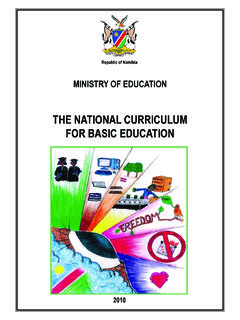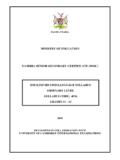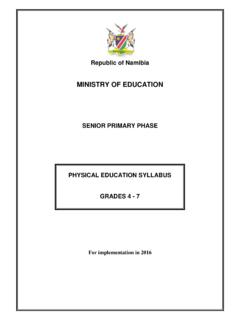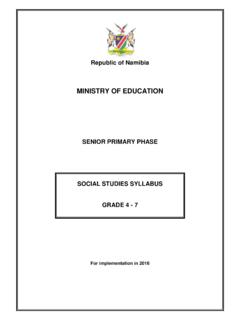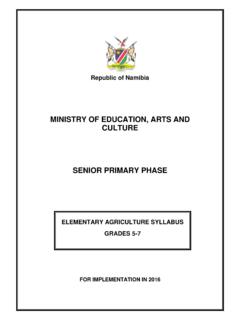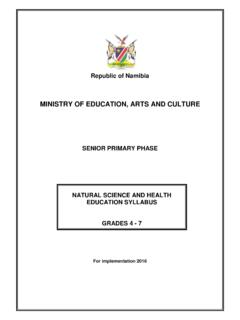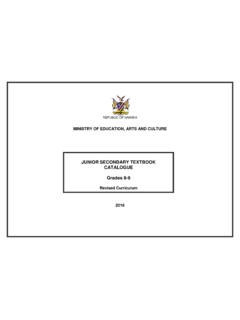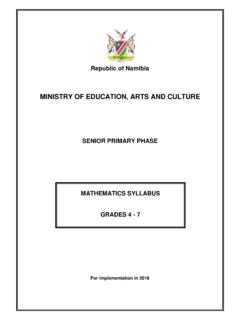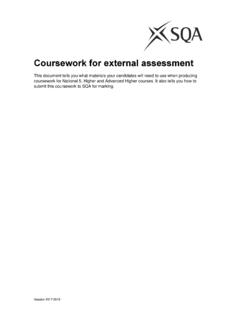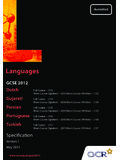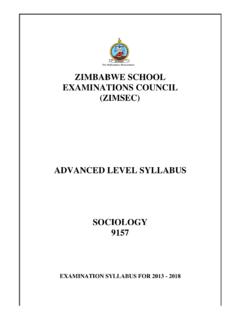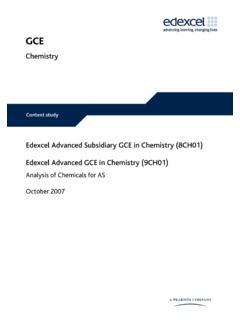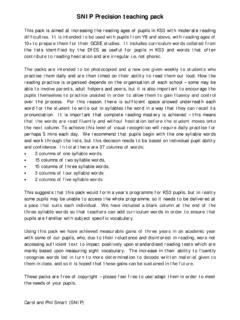Transcription of MINISTRY OF EDUCATION, ARTS AND CULTURE
1 Republic of Namibia MINISTRY OF education , arts AND CULTURE JUNIOR SECONDARY PHASE For implementation: Grade 8 in 2017 and Grade 9 in 2018 COMPUTER studies SYLLABUS GRADES 8 & 9 MINISTRY of education , arts and CULTURE National Institute for Educational Development (NIED) Private Bag 2034 Okahandja Namibia Copyright NIED, MINISTRY of education , arts and CULTURE , 2015 Computer studies Syllabus Grades 8 & 9 ISBN: 978-99945-2-133-3 Printed by NIED Website: Publication date: December 2015 TABLE OF CONTENTS 1. Introduction .. 1 2. Rationale .. 1 3. Aims .. 1 4. Inclusive education .. 1 5. Links to other subjects and cross-curricular issues .. 2 6. Approach to teaching and learning.
2 3 7. End-of-phase competencies .. 4 8. Summary of the learning content .. 5 9. Learning content .. 6 Introduction to learning content .. 6 Learning content .. 7 10. Assessment .. 30 Continuous assessment .. 30 Formative and summative assessment .. 30 Informal and formal methods .. 30 Evaluation .. 31 Criterion-referenced grades .. 31 Grade descriptors .. 32 Conducting and recording assessment .. 32 Assessment objectives .. 32 Continuous assessment: detailed guidelines .. 33 End-of-year examinations: detailed guidelines .. 34 Promotion marks .. 36 Specification grid .. 37 Assessment rubrics/criteria .. 38 Annexe 1: Glossary of terms .. 42 Annexe 2: Assessment record sheet for Grade 8 .. 48 Annexe 3: Assessment record sheet for Grade 9.
3 49 Computer studies syllabus Grades 8 - 9, NIED 2015 1 1. Introduction This syllabus describes the intended learning and assessment for Computer studies in the Junior Secondary phase. As a subject, Computer studies is within the technological area of learning in the curriculum, but has thematic links to other subjects across the curriculum. Learning about technology includes applying knowledge of how to do work more efficiently and effectively using tools, materials and processes. Technology is a specific way of solving problems through planning, design, realisation and evaluation. Learners develop the necessary knowledge, skills and attitudes to perform tasks using appropriate technology.
4 2. Rationale The application of computers has become an integral part of the present-day society, also in Namibia, to the extent that the skill to use a computer is a major requirement for many vocations and contributes to efficiency in many others. The subject Computer studies is designed to provide vocational orientation and training in this important domain and is in itself a complete course. The particular features of Computer studies at this phase are to equip learners with the skills of using communication- and computer technology (hardware and software), and to do basic computer programming. 3. Aims Computer studies promotes the following aims in the curriculum: prepare the learner to have a basic knowledge of computer technology and to be able to utilise it; enable the learner to use computer technology effectively as an aid to his/her studies ; enable the learner who continues with Computer studies as a subject to have a sound foundation to build on; broaden the horizon and insight of the learner and to make him/her aware of the possibilities and limitations of computer technology; give the learner a basic education in the methods of gathering and processing data by the use of modern technology; develop the learner s knowledge of correct computer terminology.
5 4. Inclusive education Inclusive education is the right of every learner and promotes access to and participation in the full range of educational programmes and services offered by the education system in mainstream schools. It is based on the principle of supporting and celebrating the diversity found among all learners and removing all barriers to learning. The Computer studies teacher in the Junior Secondary phase should therefore accommodate learners with special educational needs by adapting this syllabus to the needs of the learner through differentiation of teaching methods and material as indicated in the Curriculum Framework for Inclusive education : A Supplement to the National Curriculum for Basic education (2014).
6 The adaptation for assessment of learners with special educational needs must be done as prescribed in the Handbook for Centres (2014) by the Directorate of National Examinations and Assessment (DNEA). The accommodations prescribed in this handbook are not only for external examinations, but apply to learners from Grades 1 to 12. Computer studies syllabus Grades 8 - 9, NIED 2015 2 Learners who are so severely impaired that they cannot benefit from attending mainstream schools will be provided for according to their needs in learning support units, resource units or resource schools until such time that they can join a mainstream school structure, if possible. Teachers of Computer studies should strive to create a welcoming atmosphere that invites all learners to actively partake in all activities.
7 Care should be taken to cater for the diverse needs of all learners, including those with serious disadvantages and disabilities. This syllabus promotes equality of opportunity for males and females, enabling both sexes to participate equally and fully. Teachers should know and understand how to treat learners equally, and all materials should support gender equity. 5. Links to other subjects and cross-curricular issues The cross-curricular issues include environmental learning; HIV and AIDS; population education ; education for human rights and democracy (EHRD), information and communication technology (ICT) and road safety. These have been introduced to the formal curriculum to be dealt with in each subject and across all phases, because each of the issues deals with particular risks and challenges in our Namibian society.
8 All of our learners need to: understand the nature of these risks and challenges know how they will impact on our society and on the quality of life of our people now and in the future understand how these risks and challenges can be addressed on a national and global level understand how each learner can play a part in addressing these risks and challenges in their own school and local community The main risks and challenges have been identified as: the challenges and risks we face if we do not care for and manage our natural resources the challenges and risks caused by HIV and AIDS the challenges and risks to health caused by pollution, poor sanitation and waste the challenges and risks to democracy and social stability caused by inequity and governance that ignores rights and responsibilities the challenges and risks we face if we do not adhere to road safety measures the challenges and risks we face from globalisation This syllabus is exceptionally suited to address all these cross-curricular issues, since the usage of computer hardware and software and the manipulation of data and information are integral areas of the syllabus.
9 Teachers can use their creativity in planning lessons to include these issues, but it is not prescribed in the syllabus. Examples: internet research on any topic suggested by other subject teachers or guided by the cross-curricular issues and presented in a variety of formats use of spreadsheet functions to present statistics on these issues creating documents (word processing, presentations, desktop publishing (DTP), websites) containing information, graphics, charts, multimedia using Scratch to simulate certain aspects of road safety or another issue writing algorithms based on statistics gained from research on these issues Computer studies syllabus Grades 8 - 9, NIED 2015 3 Cross-curricular issues Environmental learning HIV and AIDS ICT EHRD Population education Road safety Grade 8 These topics will be covered incidentally and are not specifically mentioned in the specific objectives in the learning content of Grade 8 Grade 9 Theme 4: Internet and e-mail Know how to use the internet: search the Internet for cross-curricular issues Theme 5: Social and economic implications of computer usage 6.
10 Approach to teaching and learning The approach to teaching and learning is based on a paradigm of learner-centred education (LCE) described in ministerial policy documents and the LCE conceptual framework. This approach ensures optimal quality of learning when the principles are put into practice. The aim is to develop learning with understanding, and the knowledge, skills and attitudes to contribute to the development of society. The starting point for teaching and learning is the fact that the learner brings to the school a wealth of knowledge and social experience gained continually from the family, the community, and through interaction with the environment. Learning in school must involve, build on, extend and challenge the learner s prior knowledge and experience.
